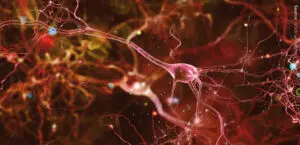About the structure and biological function of GQ1
Structure. GQ1 ganglioside lipids belong to the group of gangliosides within the sphingolipids. Their structure consists of a ceramide backbone linked to an oligosaccharide unit made of eight sugar molecules. Four of them are sialic acid. The ceramide backbone contains two hydrocarbon chains: a long-chain base which is linked to a fatty acid via an amide bond. The fatty acid and the long-chain base can be of variable length, hydroxylated, and contain double bonds.
Function. GQ1 gangliosides belong to the major gangliosides of the mammal brain. In Miller Fisher syndrome, a rare autoimmune nerve disease that is considered to be a variant of Guillain-Barré syndrome, patients have a unique antibody against GQ1 lipids. Patients experience paralysis of ocular muscles, absence of reflexes, and lack of voluntary coordination of muscle movements. Further, GQ1 levels are reduced in Alzheimer’s models and GQ1 gangliosides have been shown to interact with the cholera toxin.


